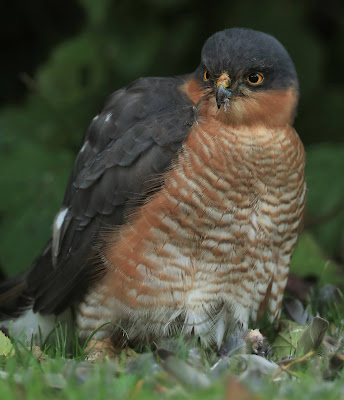Saturday, 6 November 2021
Male Sparrowhawk in the garden 29 October.
Goshawk
Friday, 5 November 2021
Visual Migration from garden 5th November (0650-0830)
Dawn on the 5th November was cool at 2 degrees Celsius, a light westerly, and eventually, bright conditions.
With a nasty abscess on my gum, I wasn't planning on going anywhere other than my garden for some vismigging. The following totals were gathered:
Thursday, 4 November 2021
August 2021
For me, August is the most anticipated of months with migration picking up a pace with focus turning to passerine species, notably Warblers and Chats. Locally, I have a number of migrant magnets which have been watched annually at this time of year.
The first notable bird was a juvenile Peregrine on 9th August at Great Cressingham, I first became aware of something when a couple of Kestrels alarm called, the Peregrine appeared low over fields and continued south-east with a noisy Kestrel seeing it off.
On the 14th I visited North Pickenham to search for migrants. Whitethroat numbers were beginning to build with double figure counts at one site. Several Blackcaps were also seen. Whilst checking an Elder for movement, I saw between branches a quivering tail, this was a lovely juvenile Redstart, this bird was only briefly seen well before flying into a thick Hawthorn where glimpses were had of the bird preening.
Always a welcome migrant on the patch is Lesser Whitethroat, a single migrant was located near Bodney on the 16th. Typically, this was a very neat looking bird with grey head and ear coverts and strongly contrasting white throat, white underparts and uniform brown upperparts. A check of Elder produce a feeding Whitethroat. A single Swift was seen over Watton later in the day.
On the 18th, 3 Stonechats were seen near Watton along a stream where they were seen on fence-posts and tops of Willowherb.
A spot count near Bodney on 20th produced 5+ Whitethroats, 4+ Blackcaps, and 5 Chiffchaffs. 2 Stonechats were seen. A beautiful Roesel's Bush Cricket was found in lush vegetation by a stream.
Following recent heavy rainfall and a persistent NNE wind, I decided on the 23rd to visit a couple of local sites which are generally good for migrant species. My first site, a lovely hedgerow corridor near North Pickenham, produced several Blackcap, Whitethroats, and Chiffchaffs, whilst 25+ Linnets and 3 Bullfinches were seen. My second site visited was close to Watton, here, a bird dropped into a large Osier, this was a lovely Whinchat, the bird remained high in the tree for a while before dropping into Umbellifers, where a juvenile Whitethroat was also seen.. 3 Stonechats seen as was 20+ Swallows.
 |
| Whinchat Great Cressingham 23 August |





